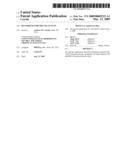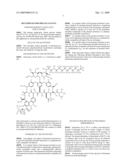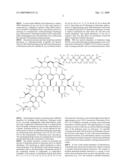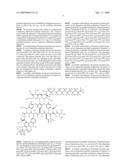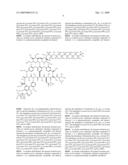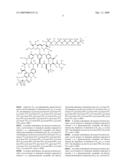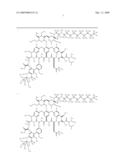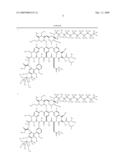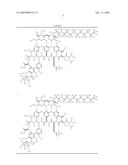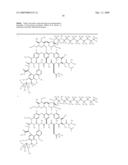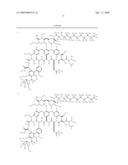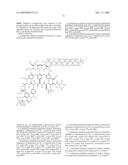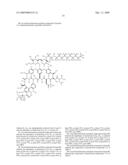Patent application title: DEUTERIUM-ENRICHED TELAVANCIN
Inventors:
Anthony W. Czarnik (Reno, NV, US)
Assignees:
PROTIA, LLC
IPC8 Class: AA61K3812FI
USPC Class:
514 7
Class name: Designated organic active ingredient containing (doai) peptide containing (e.g., protein, peptones, fibrinogen, etc.) doai phosphorus containing
Publication date: 2009-03-12
Patent application number: 20090069219
escribes deuterium-enriched telavancin,
pharmaceutically acceptable salt forms thereof, and methods of treating
using the same.Claims:
1. A deuterium-enriched compound of formula I or a pharmaceutically
acceptable salt thereof: ##STR00018## wherein R1-R53 are
independently selected from H and D; and the abundance of deuterium in
R1-R53 is at least 2%.
2. A deuterium-enriched compound of claim 1, wherein the abundance of deuterium in R1-R53 is selected from at least 2%, at least 4%, at least 9%, at least 15%, at least 21%, at least 26%, at least 32%, at least 38%, at least 43%, at least 49%, at least 55%, at least 60%, at least 66%, at least 72%, at least 77%, at least 83%, at least 89%, at least 94%, and 100%.
3. A deuterium-enriched compound of claim 1, wherein the abundance of deuterium in R1-R24 is selected from at least 4%, at least 8%, at least 13%, at least 17%, at least 21%, at least 25%, at least 29%, at least 33%, at least 38%, at least 42%, at least 46%, at least 50%, at least 54%, at least 58%, at least 63%, at least 67%, at least 71%, at least 75%, at least 79%, at least 83%, at least 88%, at least 92%, at least 96%, and 100%.
4. A deuterium-enriched compound of claim 1, wherein the abundance of deuterium in R25-R53 is selected from at least 3%, at least 7%, at least 14%, at least 21%, at least 28%, at least 34%, at least 41%, at least 48%, at least 55%, at least 62%, at least 69%, at least 76%, at least 83%, at least 90%, at least 97%, and 100%.
5. A deuterium-enriched compound of claim 1, wherein the abundance of deuterium in R25-R28 is selected from at least 25%, at least 50%, at least 75%, and 100%.
6. A deuterium-enriched compound of claim 1, wherein the abundance of deuterium in R29-R32 is selected from at least 25%, at least 50%, at least 75%, and 100%.
7. A deuterium-enriched compound of claim 1, wherein the abundance of deuterium in R33-R53 is selected from at least 5%, at least 10%, at least 14%, at least 19%, at least 24%, at least 29%, at least 33%, at least 38%, at least 43%, at least 48%, at least 52%, (k) at least 57%, at least 62%, at least 67%, at least 71%, at least 76%, at least 81%, at least 86%, at least 90%, at least 95%, and 100%.
8 . A deuterium-enriched compound of claim 1, wherein the compound is selected from compounds 1-6 of Table 1.
9 . A deuterium-enriched compound of claim 1, wherein the compound is selected from compounds 7-12 of Table 2.
10. An isolated deuterium-enriched compound of formula I or a pharmaceutically acceptable salt thereof: ##STR00019## wherein R1-R53 are independently selected from H and D; and the abundance of deuterium in R1-R53 is at least 2%.
11. An isolated deuterium-enriched compound of claim 10, wherein the abundance of deuterium in R1-R53 is selected from at least 2%, at least 4%, at least 9%, at least 15%, at least 21%, at least 26%, at least 32%, at least 38%, at least 43%, at least 49%, at least 55%, at least 60%, at least 66%, at least 72%, at least 77%, at least 83%, at least 89%, at least 94%, and 100%.
12. An isolated deuterium-enriched compound of claim 10, wherein the abundance of deuterium in R1-R24 is selected from at least 4%, at least 8%, at least 13%, at least 17%, at least 21%, at least 25%, at least 29%, at least 33%, at least 38%, at least 42%, at least 46%, at least 50%, at least 54%, at least 58%, at least 63%, at least 67%, at least 71%, at least 75%, at least 79%, at least 83%, at least 88%, at least 92%, at least 96%, and 100%.
13. An isolated deuterium-enriched compound of claim 10, wherein the abundance of deuterium in R25-R53 is selected from at least 3%, at least 7%, at least 14%, at least 21%, at least 28%, at least 34%, at least 41%, at least 48%, at least 55%, at least 62%, at least 69%, at least 76%, at least 83%, at least 90%, at least 97%, and 100%.
14. An isolated deuterium-enriched compound of claim 10, wherein the compound is selected from compounds 1-6 of Table 1.
15. An isolated deuterium-enriched compound of claim 10, wherein the compound is selected from compounds 7-12 of Table 2.
16. A mixture of deuterium-enriched compounds of formula I or a pharmaceutically acceptable salt thereof: ##STR00020## wherein R1-R53 are independently selected from H and D; and the abundance of deuterium in R1-R53 is at least 2%.
17. A mixture of deuterium-enriched compound of claim 16, wherein the compound is selected from compounds 1-6 of Table 1.
18. A mixture of deuterium-enriched compound of claim 16, wherein the compound is selected from compounds 7-12 of Table 2.
19. A pharmaceutical composition, comprising: a pharmaceutically acceptable carrier and a therapeutically effective amount of a compound of claim 1 or a pharmaceutically acceptable salt form thereof.
20. A method for treating bacterial infections comprising: administering, to a patient in need thereof, a therapeutically effective amount of a compound of claim 1 or a pharmaceutically acceptable salt form thereof.Description:
CROSS-REFERENCE TO RELATED APPLICATIONS
[0001]The present application claims priority benefit under 35 U.S.C. §119(e) of U.S. Provisional Patent Application Ser. No. 60/970,987 filed 9 Sep. 2007. The disclosure of this application is incorporated herein by reference.
FIELD OF THE INVENTION
[0002]This invention relates generally to deuterium-enriched telavancin, pharmaceutical compositions containing the same, and methods of using the same.
BACKGROUND OF THE INVENTION
[0003]Telavancin, shown below, is a well known antibiotic.
##STR00001##
Since telavancin is a known and useful pharmaceutical, it is desirable to discover novel derivatives thereof. Telavancin is described in U.S. Pat. No. 6,635,618 and U.S. Publication Nos. 2003/119722 and 2002/022590; the contents of which are incorporated herein by reference.
SUMMARY OF THE INVENTION
[0004]Accordingly, one object of the present invention is to provide deuterium-enriched telavancin or a pharmaceutically acceptable salt thereof.
[0005]It is another object of the present invention to provide pharmaceutical compositions comprising a pharmaceutically acceptable carrier and a therapeutically effective amount of at least one of the deuterium-enriched compounds of the present invention or a pharmaceutically acceptable salt thereof.
[0006]It is another object of the present invention to provide a method for treating bacterial infections, comprising administering to a host in need of such treatment a therapeutically effective amount of at least one of the deuterium-enriched compounds of the present invention or a pharmaceutically acceptable salt thereof.
[0007]It is another object of the present invention to provide a novel deuterium-enriched telavancin or a pharmaceutically acceptable salt thereof for use in therapy.
[0008]It is another object of the present invention to provide the use of a novel deuterium-enriched telavancin or a pharmaceutically acceptable salt thereof for the manufacture of a medicament (e.g., for the treatment of bacterial infections).
[0009]These and other objects, which will become apparent during the following detailed description, have been achieved by the inventor's discovery of the presently claimed deuterium-enriched telavancin.
DETAILED DESCRIPTION OF PREFERRED EMBODIMENTS
[0010]Deuterium (D or 2H) is a stable, non-radioactive isotope of hydrogen and has an atomic weight of 2.0144. Hydrogen naturally occurs as a mixture of the isotopes 1H (hydrogen or protium), D (2H or deuterium), and T (3H or tritium). The natural abundance of deuterium is 0.015%. One of ordinary skill in the art recognizes that in all chemical compounds with a H atom, the H atom actually represents a mixture of H and D, with about 0.015% being D. Thus, compounds with a level of deuterium that has been enriched to be greater than its natural abundance of 0.015%, should be considered unnatural and, as a result, novel over their non-enriched counterparts.
[0011]All percentages given for the amount of deuterium present are mole percentages.
[0012]It can be quite difficult in the laboratory to achieve 100% deuteration at any one site of a lab scale amount of compound (e.g., milligram or greater). When 100% deuteration is recited or a deuterium atom is specifically shown in a structure, it is assumed that a small percentage of hydrogen may still be present. Deuterium-enriched can be achieved by either exchanging protons with deuterium or by synthesizing the molecule with enriched starting materials.
[0013]The present invention provides deuterium-enriched telavancin or a pharmaceutically acceptable salt thereof. There are fifty-three hydrogen atoms in the telavancin portion of telavancin as show by variables R1-R53 in formula I below.
##STR00002##
[0014]The hydrogens present on telavancin have different capacities for exchange with deuterium. Hydrogen atoms R1-R24 are easily exchangeable under physiological conditions and, if replaced by deuterium atoms, it is expected that they will readily exchange for protons after administration to a patient. Hydrogen atoms R25-R53 can be replaced by deuterium atoms in various combinations during the semisynthesis of telavancin from vancomycin. See U.S. Pat. No. 6,635,618 for the semisynthesis of telavancin from vancomycin. The remaining hydrogen atoms (not numbered) are not easily incorporated during the construction of telavancin.
[0015]The present invention is based on increasing the amount of deuterium present in telavancin above its natural abundance. This increasing is called enrichment or deuterium-enrichment. If not specifically noted, the percentage of enrichment refers to the percentage of deuterium present in the compound, mixture of compounds, or composition. Examples of the amount of enrichment include from about 0.5, 1, 2, 3, 4, 5, 6, 7, 8, 9, 10, 12, 16, 21, 25, 29, 33, 37, 42, 46, 50, 54, 58, 63, 67, 71, 75, 79, 84, 88, 92, 96, to about 100 mol %. Since there are 53 hydrogens in telavancin, replacement of a single hydrogen atom with deuterium would result in a molecule with about 2% deuterium enrichment. In order to achieve enrichment less than about 2%, but above the natural abundance, only partial deuteration of one site is required. Thus, less than about 2% enrichment would still refer to deuterium-enriched telavancin.
[0016]With the natural abundance of deuterium being 0.015%, one would expect that for approximately every 6,667 molecules of telavancin (1/0.00015=6,667), there is one naturally occurring molecule with one deuterium present. Since telavancin has 53 positions, one would roughly expect that for approximately every 353,351 molecules of telavancin (53×6,667), all 53 different, naturally occurring, mono-deuterated telavancins would be present. This approximation is a rough estimate as it doesn't take into account the different exchange rates of the hydrogen atoms on telavancin. For naturally occurring molecules with more than one deuterium, the numbers become vastly larger. In view of this natural abundance, the present invention, in an embodiment, relates to an amount of an deuterium enriched compound, whereby the enrichment recited will be more than naturally occurring deuterated molecules.
[0017]In view of the natural abundance of deuterium-enriched telavancin, the present invention also relates to isolated or purified deuterium-enriched telavancin. The isolated or purified deuterium-enriched telavancin is a group of molecules whose deuterium levels are above the naturally occurring levels (e.g., 2%). The isolated or purified deuterium-enriched telavancin can be obtained by techniques known to those of skill in the art (e.g., see the syntheses described below).
[0018]The present invention also relates to compositions comprising deuterium-enriched telavancin. The compositions require the presence of deuterium-enriched telavancin which is greater than its natural abundance. For example, the compositions of the present invention can comprise (a) a μg of a deuterium-enriched telavancin; (b) a mg of a deuterium-enriched telavancin; and, (c) a gram of a deuterium-enriched telavancin.
[0019]In an embodiment, the present invention provides an amount of a novel deuterium-enriched telavancin.
[0020]Examples of amounts include, but are not limited to (a) at least 0.01, 0.02, 0.03, 0.04, 0.05, 0.1, 0.2, 0.3, 0.4, 0.5, to 1 mole, (b) at least 0.1 moles, and (c) at least 1 mole of the compound. The present amounts also cover lab-scale (e.g., gram scale), kilo-lab scale (e.g., kilogram scale), and industrial or commercial scale (e.g., multi-kilogram or above scale) quantities as these will be more useful in the actual manufacture of a pharmaceutical. Industrial/commercial scale refers to the amount of product that would be produced in a batch that was designed for clinical testing, formulation, sale/distribution to the public, etc.
[0021]In another embodiment, the present invention provides a novel, deuterium enriched compound of formula I or a pharmaceutically acceptable salt thereof.
##STR00003##
[0022]wherein R1-R53 are independently selected from H and D; and the abundance of deuterium in R1-R53 is at least 2%. The abundance can also be (a) at least 4%, (b) at least 9%, (c) at least 15%, (d) at least 21%, (e) at least 26%, (f) at least 32%, (g) at least 38%, (h) at least 43%, (i) at least 49%, (j) at least 55%, (k) at least 60%, (l) at least 66%, (m) at least 72%, (n) at least 77%, (o) at least 83%, (p) at least 89%, (q) at least 94%, and (r) 100%.
[0023]In another embodiment, the present invention provides a novel, deuterium enriched compound of formula I or a pharmaceutically acceptable salt thereof, wherein the abundance of deuterium in R1-R24 is at least 4%. The abundance can also be (a) at least 8%, (b) at least 13%, (c) at least 17%, (d) at least 21%, (e) at least 25%, (f) at least 29%, (g) at least 33%, (h) at least 38%, (i) at least 42%, (j) at least 46%, (k) at least 50%, (l) at least 54%, (m) at least 58%, (n) at least 63%, (o) at least 67%, (p) at least 71%, (q) at least 75%, (r) at least 79%, (s) at least 83%, (t) at least 88%, (u) at least 92%, (v) at least 96%, and (w) 100%.
[0024]In another embodiment, the present invention provides a novel, deuterium enriched compound of formula I or a pharmaceutically acceptable salt thereof, wherein the abundance of deuterium in R25-R53 is at least 3%. The abundance can also be (a) at least 7%, (b) at least 14%, (c) at least 21%, (d) at least 28%, (e) at least 34%, (f) at least 41%, (g) at least 48%, (h) at least 55%, (i) at least 62%, (j) at least 69%, (k) at least 76%, (l) at least 83%, (m) at least 90%, (n) at least 97%, and (o) 100%.
[0025]In another embodiment, the present invention provides a novel, deuterium enriched compound of formula I or a pharmaceutically acceptable salt thereof, wherein the abundance of deuterium in R25-R28 is at least 25%. The abundance can also be (a) at least 50%, (b) at least 75%, and (c) 100%.
[0026]In another embodiment, the present invention provides a novel, deuterium enriched compound of formula I or a pharmaceutically acceptable salt thereof, wherein the abundance of deuterium in R29-R32 is at least 25%. The abundance can also be (a) at least 50%, (b) at least 75%, and (c) 100%.
[0027]In another embodiment, the present invention provides a novel, deuterium enriched compound of formula I or a pharmaceutically acceptable salt thereof, wherein the abundance of deuterium in R33-R53 is at least 5%. The abundance can also be (a) at least 10%, (b) at least 14%, (c) at least 19%, (d) at least 24%, (e) at least 29%, (f) at least 33%, (g) at least 38%, (h) at least 43%, (i) at least 48%, (j) at least 52%, (k) at least 57%, (l) at least 62%, (m) at least 67%, (n) at least 71%, (o) at least 76%, (p) at least 81%, (q) at least 86%, (r) at least 90%, (s) at least 95%, and (t) 100%.
[0028]In another embodiment, the present invention provides an isolated novel, deuterium enriched compound of formula I or a pharmaceutically acceptable salt thereof.
##STR00004##
[0029]wherein R1-R53 are independently selected from H and D; and the abundance of deuterium in R1-R53 is at least 2%. The abundance can also be (a) at least 4%, (b) at least 9%, (c) at least 15%, (d) at least 21%, (e) at least 26%, (f) at least 32%, (g) at least 38%, (h) at least 43%, (i) at least 49%, (j) at least 55%, (k) at least 60%, (l) at least 66%, (m) at least 72%, (n) at least 77%, (o) at least 83%, (p) at least 89%, (q) at least 94%, and (r) 100%.
[0030]In another embodiment, the present invention provides an isolated novel, deuterium enriched compound of formula I or a pharmaceutically acceptable salt thereof, wherein the abundance of deuterium in R1-R24 is at least 4%. The abundance can also be (a) at least 8%, (b) at least 13%, (c) at least 17%, (d) at least 21%, (e) at least 25%, (f) at least 29%, (g) at least 33%, (h) at least 38%, (i) at least 42%, (j) at least 46%, (k) at least 50%, (l) at least 54%, (m) at least 58%, (n) at least 63%, (o) at least 67%, (p) at least 71%, (q) at least 75%, (r) at least 79%, (s) at least 83%, (t) at least 88%, (u) at least 92%, (v) at least 96%, and (w) 100%.
[0031]In another embodiment, the present invention provides an isolated novel, deuterium enriched compound of formula I or a pharmaceutically acceptable salt thereof, wherein the abundance of deuterium in R25-R53 is at least 3%. The abundance can also be (a) at least 7%, (b) at least 14%, (c) at least 21%, (d) at least 28%, (e) at least 34%, (f) at least 41%, (g) at least 48%, (h) at least 55%, (i) at least 62%, (j) at least 69%, (k) at least 76%, (l) at least 83%, (m) at least 90%, (n) at least 97%, and (o) 100%.
[0032]In another embodiment, the present invention provides an isolated novel, deuterium enriched compound of formula I or a pharmaceutically acceptable salt thereof, wherein the abundance of deuterium in R25-R28 is at least 25%. The abundance can also be (a) at least 50%, (b) at least 75%, and (c) 100%.
[0033]In another embodiment, the present invention provides an isolated novel, deuterium enriched compound of formula I or a pharmaceutically acceptable salt thereof, wherein the abundance of deuterium in R29-R32 is at least 25%. The abundance can also be (a) at least 50%, (b) at least 75%, and (c) 100%.
[0034]In another embodiment, the present invention provides an isolated novel, deuterium enriched compound of formula I or a pharmaceutically acceptable salt thereof, wherein the abundance of deuterium in R33-R53 is at least 5%. The abundance can also be (a) at least 10%, (b) at least 14%, (c) at least 19%, (d) at least 24%, (e) at least 29%, (f) at least 33%, (g) at least 38%, (h) at least 43%, (i) at least 48%, (j) at least 52%, (k) at least 57%, (l) at least 62%, (m) at least 67%, (n) at least 71%, (o) at least 76%, (p) at least 81%, (q) at least 86%, (r) at least 90%, (s) at least 95%, and (t) 100%.
[0035]In another embodiment, the present invention provides novel mixture of deuterium enriched compounds of formula I or a pharmaceutically acceptable salt thereof.
##STR00005##
[0036]wherein R1-R53 are independently selected from H and D; and the abundance of deuterium in R1-R53 is at least 2%. The abundance can also be (a) at least 4%, (b) at least 9%, (c) at least 15%, (d) at least 21%, (e) at least 26%, (f) at least 32%, (g) at least 38%, (h) at least 43%, (i) at least 49%, (j) at least 55%, (k) at least 60%, (l) at least 66%, (m) at least 72%, (n) at least 77%, (o) at least 83%, (p) at least 89%, (q) at least 94%, and (r) 100%.
[0037]In another embodiment, the present invention provides a novel mixture of, deuterium enriched compound of formula I or a pharmaceutically acceptable salt thereof, wherein the abundance of deuterium in R1-R24 is at least 4%. The abundance can also be (a) at least 8%, (b) at least 13%, (c) at least 17%, (d) at least 21%, (e) at least 25%, (f) at least 29%, (g) at least 33%, (h) at least 38%, (i) at least 42%, (j) at least 46%, (k) at least 50%, (l) at least 54%, (m) at least 58%, (n) at least 63%, (o) at least 67%, (p) at least 71%, (q) at least 75%, (r) at least 79%, (s) at least 83%, (t) at least 88%, (u) at least 92%, (v) at least 96%, and (w) 100%.
[0038]In another embodiment, the present invention provides a novel mixture of, deuterium enriched compound of formula I or a pharmaceutically acceptable salt thereof, wherein the abundance of deuterium in R25-R53 is at least 3%. The abundance can also be (a) at least 7%, (b) at least 14%, (c) at least 21%, (d) at least 28%, (e) at least 34%, (f) at least 41%, (g) at least 48%, (h) at least 55%, (i) at least 62%, (j) at least 69%, (k) at least 76%, (l) at least 83%, (m) at least 90%, (n) at least 97%, and (o) 100%.
[0039]In another embodiment, the present invention provides a novel mixture of, deuterium enriched compound of formula I or a pharmaceutically acceptable salt thereof, wherein the abundance of deuterium in R25-R28 is at least 25%. The abundance can also be (a) at least 50%, (b) at least 75%, and (c) 100%.
[0040]In another embodiment, the present invention provides a novel mixture of, deuterium enriched compound of formula I or a pharmaceutically acceptable salt thereof, wherein the abundance of deuterium in R29-R32 is at least 25%. The abundance can also be (a) at least 50%, (b) at least 75%, and (c) 100%.
[0041]In another embodiment, the present invention provides a novel mixture of, deuterium enriched compound of formula I or a pharmaceutically acceptable salt thereof, wherein the abundance of deuterium in R33-R53 is at least 5%. The abundance can also be (a) at least 10%, (b) at least 14%, (c) at least 19%, (d) at least 24%, (e) at least 29%, (f) at least 33%, (g) at least 38%, (h) at least 43%, (i) at least 48%, (j) at least 52%, (k) at least 57%, (l) at least 62%, (m) at least 67%, (n) at least 71%, (o) at least 76%, (p) at least 81%, (q) at least 86%, (r) at least 90%, (s) at least 95%, and (t) 100%.
[0042]In another embodiment, the present invention provides novel pharmaceutical compositions, comprising: a pharmaceutically acceptable carrier and a therapeutically effective amount of a deuterium-enriched compound of the present invention.
[0043]In another embodiment, the present invention provides a novel method for treating bacterial infections comprising: administering to a patient in need thereof a therapeutically effective amount of a deuterium-enriched compound of the present invention.
[0044]In another embodiment, the present invention provides an amount of a deuterium-enriched compound of the present invention as described above for use in therapy.
[0045]In another embodiment, the present invention provides the use of an amount of a deuterium-enriched compound of the present invention for the manufacture of a medicament (e.g., for the treatment of bacterial infections).
[0046]The present invention may be embodied in other specific forms without departing from the spirit or essential attributes thereof. This invention encompasses all combinations of preferred aspects of the invention noted herein. It is understood that any and all embodiments of the present invention may be taken in conjunction with any other embodiment or embodiments to describe additional more preferred embodiments. It is also to be understood that each individual element of the preferred embodiments is intended to be taken individually as its own independent preferred embodiment. Furthermore, any element of an embodiment is meant to be combined with any and all other elements from any embodiment to describe an additional embodiment.
DEFINITIONS
[0047]The examples provided in the definitions present in this application are non-inclusive unless otherwise stated. They include but are not limited to the recited examples.
[0048]The compounds of the present invention may have asymmetric centers. Compounds of the present invention containing an asymmetrically substituted atom may be isolated in optically active or racemic forms. It is well known in the art how to prepare optically active forms, such as by resolution of racemic forms or by synthesis from optically active starting materials. All processes used to prepare compounds of the present invention and intermediates made therein are considered to be part of the present invention. All tautomers of shown or described compounds are also considered to be part of the present invention.
[0049]"Host" preferably refers to a human. It also includes other mammals including the equine, porcine, bovine, feline, and canine families.
[0050]"Treating" or "treatment" covers the treatment of a disease-state in a mammal, and includes: (a) preventing the disease-state from occurring in a mammal, in particular, when such mammal is predisposed to the disease-state but has not yet been diagnosed as having it; (b) inhibiting the disease-state, e.g., arresting it development; and/or (c) relieving the disease-state, e.g., causing regression of the disease state until a desired endpoint is reached. Treating also includes the amelioration of a symptom of a disease (e.g., lessen the pain or discomfort), wherein such amelioration may or may not be directly affecting the disease (e.g., cause, transmission, expression, etc.).
[0051]"Therapeutically effective amount" includes an amount of a compound of the present invention that is effective when administered alone or in combination to treat the desired condition or disorder. "Therapeutically effective amount" includes an amount of the combination of compounds claimed that is effective to treat the desired condition or disorder. The combination of compounds is preferably a synergistic combination. Synergy, as described, for example, by Chou and Talalay, Adv. Enzyme Regul. 1984, 22:27-55, occurs when the effect of the compounds when administered in combination is greater than the additive effect of the compounds when administered alone as a single agent. In general, a synergistic effect is most clearly demonstrated at sub-optimal concentrations of the compounds. Synergy can be in terms of lower cytotoxicity, increased antiviral effect, or some other beneficial effect of the combination compared with the individual components.
[0052]"Pharmaceutically acceptable salts" refer to derivatives of the disclosed compounds wherein the parent compound is modified by making acid or base salts thereof. Examples of pharmaceutically acceptable salts include, but are not limited to, mineral or organic acid salts of the basic residues. The pharmaceutically acceptable salts include the conventional quaternary ammonium salts of the parent compound formed, for example, from non-toxic inorganic or organic acids. For example, such conventional non-toxic salts include, but are not limited to, those derived from inorganic and organic acids selected from 1,2-ethanedisulfonic, 2-acetoxybenzoic, 2-hydroxyethanesulfonic, acetic, ascorbic, benzenesulfonic, benzoic, bicarbonic, carbonic, citric, edetic, ethane disulfonic, ethane sulfonic, fumaric, glucoheptonic, gluconic, glutamic, glycolic, glycollyarsanilic, hexylresorcinic, hydrabamic, hydrobromic, hydrochloric, hydroiodide, hydroxymaleic, hydroxynaphthoic, isethionic, lactic, lactobionic, lauryl sulfonic, maleic, malic, mandelic, methanesulfonic, napsylic, nitric, oxalic, pamoic, pantothenic, phenylacetic, phosphoric, polygalacturonic, propionic, salicyclic, stearic, subacetic, succinic, sulfamic, sulfanilic, sulfuric, tannic, tartaric, and toluenesulfonic.
EXAMPLES
[0053]Table 1 provides compounds that are representative examples of the present invention. When one of R1-R53 is present, it is selected from H or D.
TABLE-US-00001 1 ##STR00006## 2 ##STR00007## 3 ##STR00008## 4 ##STR00009## 5 ##STR00010## 6 ##STR00011##
[0054]Table 2 provides compounds that are representative examples of the present invention. Where H is shown, it represents naturally abundant hydrogen.
TABLE-US-00002 7 ##STR00012## 8 ##STR00013## 9 ##STR00014## 10 ##STR00015## 11 ##STR00016## 12 ##STR00017##
[0055]Numerous modifications and variations of the present invention are possible in light of the above teachings. It is therefore to be understood that within the scope of the appended claims, the invention may be practiced otherwise that as specifically described herein.
Claims:
1. A deuterium-enriched compound of formula I or a pharmaceutically
acceptable salt thereof: ##STR00018## wherein R1-R53 are
independently selected from H and D; and the abundance of deuterium in
R1-R53 is at least 2%.
2. A deuterium-enriched compound of claim 1, wherein the abundance of deuterium in R1-R53 is selected from at least 2%, at least 4%, at least 9%, at least 15%, at least 21%, at least 26%, at least 32%, at least 38%, at least 43%, at least 49%, at least 55%, at least 60%, at least 66%, at least 72%, at least 77%, at least 83%, at least 89%, at least 94%, and 100%.
3. A deuterium-enriched compound of claim 1, wherein the abundance of deuterium in R1-R24 is selected from at least 4%, at least 8%, at least 13%, at least 17%, at least 21%, at least 25%, at least 29%, at least 33%, at least 38%, at least 42%, at least 46%, at least 50%, at least 54%, at least 58%, at least 63%, at least 67%, at least 71%, at least 75%, at least 79%, at least 83%, at least 88%, at least 92%, at least 96%, and 100%.
4. A deuterium-enriched compound of claim 1, wherein the abundance of deuterium in R25-R53 is selected from at least 3%, at least 7%, at least 14%, at least 21%, at least 28%, at least 34%, at least 41%, at least 48%, at least 55%, at least 62%, at least 69%, at least 76%, at least 83%, at least 90%, at least 97%, and 100%.
5. A deuterium-enriched compound of claim 1, wherein the abundance of deuterium in R25-R28 is selected from at least 25%, at least 50%, at least 75%, and 100%.
6. A deuterium-enriched compound of claim 1, wherein the abundance of deuterium in R29-R32 is selected from at least 25%, at least 50%, at least 75%, and 100%.
7. A deuterium-enriched compound of claim 1, wherein the abundance of deuterium in R33-R53 is selected from at least 5%, at least 10%, at least 14%, at least 19%, at least 24%, at least 29%, at least 33%, at least 38%, at least 43%, at least 48%, at least 52%, (k) at least 57%, at least 62%, at least 67%, at least 71%, at least 76%, at least 81%, at least 86%, at least 90%, at least 95%, and 100%.
8 . A deuterium-enriched compound of claim 1, wherein the compound is selected from compounds 1-6 of Table 1.
9 . A deuterium-enriched compound of claim 1, wherein the compound is selected from compounds 7-12 of Table 2.
10. An isolated deuterium-enriched compound of formula I or a pharmaceutically acceptable salt thereof: ##STR00019## wherein R1-R53 are independently selected from H and D; and the abundance of deuterium in R1-R53 is at least 2%.
11. An isolated deuterium-enriched compound of claim 10, wherein the abundance of deuterium in R1-R53 is selected from at least 2%, at least 4%, at least 9%, at least 15%, at least 21%, at least 26%, at least 32%, at least 38%, at least 43%, at least 49%, at least 55%, at least 60%, at least 66%, at least 72%, at least 77%, at least 83%, at least 89%, at least 94%, and 100%.
12. An isolated deuterium-enriched compound of claim 10, wherein the abundance of deuterium in R1-R24 is selected from at least 4%, at least 8%, at least 13%, at least 17%, at least 21%, at least 25%, at least 29%, at least 33%, at least 38%, at least 42%, at least 46%, at least 50%, at least 54%, at least 58%, at least 63%, at least 67%, at least 71%, at least 75%, at least 79%, at least 83%, at least 88%, at least 92%, at least 96%, and 100%.
13. An isolated deuterium-enriched compound of claim 10, wherein the abundance of deuterium in R25-R53 is selected from at least 3%, at least 7%, at least 14%, at least 21%, at least 28%, at least 34%, at least 41%, at least 48%, at least 55%, at least 62%, at least 69%, at least 76%, at least 83%, at least 90%, at least 97%, and 100%.
14. An isolated deuterium-enriched compound of claim 10, wherein the compound is selected from compounds 1-6 of Table 1.
15. An isolated deuterium-enriched compound of claim 10, wherein the compound is selected from compounds 7-12 of Table 2.
16. A mixture of deuterium-enriched compounds of formula I or a pharmaceutically acceptable salt thereof: ##STR00020## wherein R1-R53 are independently selected from H and D; and the abundance of deuterium in R1-R53 is at least 2%.
17. A mixture of deuterium-enriched compound of claim 16, wherein the compound is selected from compounds 1-6 of Table 1.
18. A mixture of deuterium-enriched compound of claim 16, wherein the compound is selected from compounds 7-12 of Table 2.
19. A pharmaceutical composition, comprising: a pharmaceutically acceptable carrier and a therapeutically effective amount of a compound of claim 1 or a pharmaceutically acceptable salt form thereof.
20. A method for treating bacterial infections comprising: administering, to a patient in need thereof, a therapeutically effective amount of a compound of claim 1 or a pharmaceutically acceptable salt form thereof.
Description:
CROSS-REFERENCE TO RELATED APPLICATIONS
[0001]The present application claims priority benefit under 35 U.S.C. §119(e) of U.S. Provisional Patent Application Ser. No. 60/970,987 filed 9 Sep. 2007. The disclosure of this application is incorporated herein by reference.
FIELD OF THE INVENTION
[0002]This invention relates generally to deuterium-enriched telavancin, pharmaceutical compositions containing the same, and methods of using the same.
BACKGROUND OF THE INVENTION
[0003]Telavancin, shown below, is a well known antibiotic.
##STR00001##
Since telavancin is a known and useful pharmaceutical, it is desirable to discover novel derivatives thereof. Telavancin is described in U.S. Pat. No. 6,635,618 and U.S. Publication Nos. 2003/119722 and 2002/022590; the contents of which are incorporated herein by reference.
SUMMARY OF THE INVENTION
[0004]Accordingly, one object of the present invention is to provide deuterium-enriched telavancin or a pharmaceutically acceptable salt thereof.
[0005]It is another object of the present invention to provide pharmaceutical compositions comprising a pharmaceutically acceptable carrier and a therapeutically effective amount of at least one of the deuterium-enriched compounds of the present invention or a pharmaceutically acceptable salt thereof.
[0006]It is another object of the present invention to provide a method for treating bacterial infections, comprising administering to a host in need of such treatment a therapeutically effective amount of at least one of the deuterium-enriched compounds of the present invention or a pharmaceutically acceptable salt thereof.
[0007]It is another object of the present invention to provide a novel deuterium-enriched telavancin or a pharmaceutically acceptable salt thereof for use in therapy.
[0008]It is another object of the present invention to provide the use of a novel deuterium-enriched telavancin or a pharmaceutically acceptable salt thereof for the manufacture of a medicament (e.g., for the treatment of bacterial infections).
[0009]These and other objects, which will become apparent during the following detailed description, have been achieved by the inventor's discovery of the presently claimed deuterium-enriched telavancin.
DETAILED DESCRIPTION OF PREFERRED EMBODIMENTS
[0010]Deuterium (D or 2H) is a stable, non-radioactive isotope of hydrogen and has an atomic weight of 2.0144. Hydrogen naturally occurs as a mixture of the isotopes 1H (hydrogen or protium), D (2H or deuterium), and T (3H or tritium). The natural abundance of deuterium is 0.015%. One of ordinary skill in the art recognizes that in all chemical compounds with a H atom, the H atom actually represents a mixture of H and D, with about 0.015% being D. Thus, compounds with a level of deuterium that has been enriched to be greater than its natural abundance of 0.015%, should be considered unnatural and, as a result, novel over their non-enriched counterparts.
[0011]All percentages given for the amount of deuterium present are mole percentages.
[0012]It can be quite difficult in the laboratory to achieve 100% deuteration at any one site of a lab scale amount of compound (e.g., milligram or greater). When 100% deuteration is recited or a deuterium atom is specifically shown in a structure, it is assumed that a small percentage of hydrogen may still be present. Deuterium-enriched can be achieved by either exchanging protons with deuterium or by synthesizing the molecule with enriched starting materials.
[0013]The present invention provides deuterium-enriched telavancin or a pharmaceutically acceptable salt thereof. There are fifty-three hydrogen atoms in the telavancin portion of telavancin as show by variables R1-R53 in formula I below.
##STR00002##
[0014]The hydrogens present on telavancin have different capacities for exchange with deuterium. Hydrogen atoms R1-R24 are easily exchangeable under physiological conditions and, if replaced by deuterium atoms, it is expected that they will readily exchange for protons after administration to a patient. Hydrogen atoms R25-R53 can be replaced by deuterium atoms in various combinations during the semisynthesis of telavancin from vancomycin. See U.S. Pat. No. 6,635,618 for the semisynthesis of telavancin from vancomycin. The remaining hydrogen atoms (not numbered) are not easily incorporated during the construction of telavancin.
[0015]The present invention is based on increasing the amount of deuterium present in telavancin above its natural abundance. This increasing is called enrichment or deuterium-enrichment. If not specifically noted, the percentage of enrichment refers to the percentage of deuterium present in the compound, mixture of compounds, or composition. Examples of the amount of enrichment include from about 0.5, 1, 2, 3, 4, 5, 6, 7, 8, 9, 10, 12, 16, 21, 25, 29, 33, 37, 42, 46, 50, 54, 58, 63, 67, 71, 75, 79, 84, 88, 92, 96, to about 100 mol %. Since there are 53 hydrogens in telavancin, replacement of a single hydrogen atom with deuterium would result in a molecule with about 2% deuterium enrichment. In order to achieve enrichment less than about 2%, but above the natural abundance, only partial deuteration of one site is required. Thus, less than about 2% enrichment would still refer to deuterium-enriched telavancin.
[0016]With the natural abundance of deuterium being 0.015%, one would expect that for approximately every 6,667 molecules of telavancin (1/0.00015=6,667), there is one naturally occurring molecule with one deuterium present. Since telavancin has 53 positions, one would roughly expect that for approximately every 353,351 molecules of telavancin (53×6,667), all 53 different, naturally occurring, mono-deuterated telavancins would be present. This approximation is a rough estimate as it doesn't take into account the different exchange rates of the hydrogen atoms on telavancin. For naturally occurring molecules with more than one deuterium, the numbers become vastly larger. In view of this natural abundance, the present invention, in an embodiment, relates to an amount of an deuterium enriched compound, whereby the enrichment recited will be more than naturally occurring deuterated molecules.
[0017]In view of the natural abundance of deuterium-enriched telavancin, the present invention also relates to isolated or purified deuterium-enriched telavancin. The isolated or purified deuterium-enriched telavancin is a group of molecules whose deuterium levels are above the naturally occurring levels (e.g., 2%). The isolated or purified deuterium-enriched telavancin can be obtained by techniques known to those of skill in the art (e.g., see the syntheses described below).
[0018]The present invention also relates to compositions comprising deuterium-enriched telavancin. The compositions require the presence of deuterium-enriched telavancin which is greater than its natural abundance. For example, the compositions of the present invention can comprise (a) a μg of a deuterium-enriched telavancin; (b) a mg of a deuterium-enriched telavancin; and, (c) a gram of a deuterium-enriched telavancin.
[0019]In an embodiment, the present invention provides an amount of a novel deuterium-enriched telavancin.
[0020]Examples of amounts include, but are not limited to (a) at least 0.01, 0.02, 0.03, 0.04, 0.05, 0.1, 0.2, 0.3, 0.4, 0.5, to 1 mole, (b) at least 0.1 moles, and (c) at least 1 mole of the compound. The present amounts also cover lab-scale (e.g., gram scale), kilo-lab scale (e.g., kilogram scale), and industrial or commercial scale (e.g., multi-kilogram or above scale) quantities as these will be more useful in the actual manufacture of a pharmaceutical. Industrial/commercial scale refers to the amount of product that would be produced in a batch that was designed for clinical testing, formulation, sale/distribution to the public, etc.
[0021]In another embodiment, the present invention provides a novel, deuterium enriched compound of formula I or a pharmaceutically acceptable salt thereof.
##STR00003##
[0022]wherein R1-R53 are independently selected from H and D; and the abundance of deuterium in R1-R53 is at least 2%. The abundance can also be (a) at least 4%, (b) at least 9%, (c) at least 15%, (d) at least 21%, (e) at least 26%, (f) at least 32%, (g) at least 38%, (h) at least 43%, (i) at least 49%, (j) at least 55%, (k) at least 60%, (l) at least 66%, (m) at least 72%, (n) at least 77%, (o) at least 83%, (p) at least 89%, (q) at least 94%, and (r) 100%.
[0023]In another embodiment, the present invention provides a novel, deuterium enriched compound of formula I or a pharmaceutically acceptable salt thereof, wherein the abundance of deuterium in R1-R24 is at least 4%. The abundance can also be (a) at least 8%, (b) at least 13%, (c) at least 17%, (d) at least 21%, (e) at least 25%, (f) at least 29%, (g) at least 33%, (h) at least 38%, (i) at least 42%, (j) at least 46%, (k) at least 50%, (l) at least 54%, (m) at least 58%, (n) at least 63%, (o) at least 67%, (p) at least 71%, (q) at least 75%, (r) at least 79%, (s) at least 83%, (t) at least 88%, (u) at least 92%, (v) at least 96%, and (w) 100%.
[0024]In another embodiment, the present invention provides a novel, deuterium enriched compound of formula I or a pharmaceutically acceptable salt thereof, wherein the abundance of deuterium in R25-R53 is at least 3%. The abundance can also be (a) at least 7%, (b) at least 14%, (c) at least 21%, (d) at least 28%, (e) at least 34%, (f) at least 41%, (g) at least 48%, (h) at least 55%, (i) at least 62%, (j) at least 69%, (k) at least 76%, (l) at least 83%, (m) at least 90%, (n) at least 97%, and (o) 100%.
[0025]In another embodiment, the present invention provides a novel, deuterium enriched compound of formula I or a pharmaceutically acceptable salt thereof, wherein the abundance of deuterium in R25-R28 is at least 25%. The abundance can also be (a) at least 50%, (b) at least 75%, and (c) 100%.
[0026]In another embodiment, the present invention provides a novel, deuterium enriched compound of formula I or a pharmaceutically acceptable salt thereof, wherein the abundance of deuterium in R29-R32 is at least 25%. The abundance can also be (a) at least 50%, (b) at least 75%, and (c) 100%.
[0027]In another embodiment, the present invention provides a novel, deuterium enriched compound of formula I or a pharmaceutically acceptable salt thereof, wherein the abundance of deuterium in R33-R53 is at least 5%. The abundance can also be (a) at least 10%, (b) at least 14%, (c) at least 19%, (d) at least 24%, (e) at least 29%, (f) at least 33%, (g) at least 38%, (h) at least 43%, (i) at least 48%, (j) at least 52%, (k) at least 57%, (l) at least 62%, (m) at least 67%, (n) at least 71%, (o) at least 76%, (p) at least 81%, (q) at least 86%, (r) at least 90%, (s) at least 95%, and (t) 100%.
[0028]In another embodiment, the present invention provides an isolated novel, deuterium enriched compound of formula I or a pharmaceutically acceptable salt thereof.
##STR00004##
[0029]wherein R1-R53 are independently selected from H and D; and the abundance of deuterium in R1-R53 is at least 2%. The abundance can also be (a) at least 4%, (b) at least 9%, (c) at least 15%, (d) at least 21%, (e) at least 26%, (f) at least 32%, (g) at least 38%, (h) at least 43%, (i) at least 49%, (j) at least 55%, (k) at least 60%, (l) at least 66%, (m) at least 72%, (n) at least 77%, (o) at least 83%, (p) at least 89%, (q) at least 94%, and (r) 100%.
[0030]In another embodiment, the present invention provides an isolated novel, deuterium enriched compound of formula I or a pharmaceutically acceptable salt thereof, wherein the abundance of deuterium in R1-R24 is at least 4%. The abundance can also be (a) at least 8%, (b) at least 13%, (c) at least 17%, (d) at least 21%, (e) at least 25%, (f) at least 29%, (g) at least 33%, (h) at least 38%, (i) at least 42%, (j) at least 46%, (k) at least 50%, (l) at least 54%, (m) at least 58%, (n) at least 63%, (o) at least 67%, (p) at least 71%, (q) at least 75%, (r) at least 79%, (s) at least 83%, (t) at least 88%, (u) at least 92%, (v) at least 96%, and (w) 100%.
[0031]In another embodiment, the present invention provides an isolated novel, deuterium enriched compound of formula I or a pharmaceutically acceptable salt thereof, wherein the abundance of deuterium in R25-R53 is at least 3%. The abundance can also be (a) at least 7%, (b) at least 14%, (c) at least 21%, (d) at least 28%, (e) at least 34%, (f) at least 41%, (g) at least 48%, (h) at least 55%, (i) at least 62%, (j) at least 69%, (k) at least 76%, (l) at least 83%, (m) at least 90%, (n) at least 97%, and (o) 100%.
[0032]In another embodiment, the present invention provides an isolated novel, deuterium enriched compound of formula I or a pharmaceutically acceptable salt thereof, wherein the abundance of deuterium in R25-R28 is at least 25%. The abundance can also be (a) at least 50%, (b) at least 75%, and (c) 100%.
[0033]In another embodiment, the present invention provides an isolated novel, deuterium enriched compound of formula I or a pharmaceutically acceptable salt thereof, wherein the abundance of deuterium in R29-R32 is at least 25%. The abundance can also be (a) at least 50%, (b) at least 75%, and (c) 100%.
[0034]In another embodiment, the present invention provides an isolated novel, deuterium enriched compound of formula I or a pharmaceutically acceptable salt thereof, wherein the abundance of deuterium in R33-R53 is at least 5%. The abundance can also be (a) at least 10%, (b) at least 14%, (c) at least 19%, (d) at least 24%, (e) at least 29%, (f) at least 33%, (g) at least 38%, (h) at least 43%, (i) at least 48%, (j) at least 52%, (k) at least 57%, (l) at least 62%, (m) at least 67%, (n) at least 71%, (o) at least 76%, (p) at least 81%, (q) at least 86%, (r) at least 90%, (s) at least 95%, and (t) 100%.
[0035]In another embodiment, the present invention provides novel mixture of deuterium enriched compounds of formula I or a pharmaceutically acceptable salt thereof.
##STR00005##
[0036]wherein R1-R53 are independently selected from H and D; and the abundance of deuterium in R1-R53 is at least 2%. The abundance can also be (a) at least 4%, (b) at least 9%, (c) at least 15%, (d) at least 21%, (e) at least 26%, (f) at least 32%, (g) at least 38%, (h) at least 43%, (i) at least 49%, (j) at least 55%, (k) at least 60%, (l) at least 66%, (m) at least 72%, (n) at least 77%, (o) at least 83%, (p) at least 89%, (q) at least 94%, and (r) 100%.
[0037]In another embodiment, the present invention provides a novel mixture of, deuterium enriched compound of formula I or a pharmaceutically acceptable salt thereof, wherein the abundance of deuterium in R1-R24 is at least 4%. The abundance can also be (a) at least 8%, (b) at least 13%, (c) at least 17%, (d) at least 21%, (e) at least 25%, (f) at least 29%, (g) at least 33%, (h) at least 38%, (i) at least 42%, (j) at least 46%, (k) at least 50%, (l) at least 54%, (m) at least 58%, (n) at least 63%, (o) at least 67%, (p) at least 71%, (q) at least 75%, (r) at least 79%, (s) at least 83%, (t) at least 88%, (u) at least 92%, (v) at least 96%, and (w) 100%.
[0038]In another embodiment, the present invention provides a novel mixture of, deuterium enriched compound of formula I or a pharmaceutically acceptable salt thereof, wherein the abundance of deuterium in R25-R53 is at least 3%. The abundance can also be (a) at least 7%, (b) at least 14%, (c) at least 21%, (d) at least 28%, (e) at least 34%, (f) at least 41%, (g) at least 48%, (h) at least 55%, (i) at least 62%, (j) at least 69%, (k) at least 76%, (l) at least 83%, (m) at least 90%, (n) at least 97%, and (o) 100%.
[0039]In another embodiment, the present invention provides a novel mixture of, deuterium enriched compound of formula I or a pharmaceutically acceptable salt thereof, wherein the abundance of deuterium in R25-R28 is at least 25%. The abundance can also be (a) at least 50%, (b) at least 75%, and (c) 100%.
[0040]In another embodiment, the present invention provides a novel mixture of, deuterium enriched compound of formula I or a pharmaceutically acceptable salt thereof, wherein the abundance of deuterium in R29-R32 is at least 25%. The abundance can also be (a) at least 50%, (b) at least 75%, and (c) 100%.
[0041]In another embodiment, the present invention provides a novel mixture of, deuterium enriched compound of formula I or a pharmaceutically acceptable salt thereof, wherein the abundance of deuterium in R33-R53 is at least 5%. The abundance can also be (a) at least 10%, (b) at least 14%, (c) at least 19%, (d) at least 24%, (e) at least 29%, (f) at least 33%, (g) at least 38%, (h) at least 43%, (i) at least 48%, (j) at least 52%, (k) at least 57%, (l) at least 62%, (m) at least 67%, (n) at least 71%, (o) at least 76%, (p) at least 81%, (q) at least 86%, (r) at least 90%, (s) at least 95%, and (t) 100%.
[0042]In another embodiment, the present invention provides novel pharmaceutical compositions, comprising: a pharmaceutically acceptable carrier and a therapeutically effective amount of a deuterium-enriched compound of the present invention.
[0043]In another embodiment, the present invention provides a novel method for treating bacterial infections comprising: administering to a patient in need thereof a therapeutically effective amount of a deuterium-enriched compound of the present invention.
[0044]In another embodiment, the present invention provides an amount of a deuterium-enriched compound of the present invention as described above for use in therapy.
[0045]In another embodiment, the present invention provides the use of an amount of a deuterium-enriched compound of the present invention for the manufacture of a medicament (e.g., for the treatment of bacterial infections).
[0046]The present invention may be embodied in other specific forms without departing from the spirit or essential attributes thereof. This invention encompasses all combinations of preferred aspects of the invention noted herein. It is understood that any and all embodiments of the present invention may be taken in conjunction with any other embodiment or embodiments to describe additional more preferred embodiments. It is also to be understood that each individual element of the preferred embodiments is intended to be taken individually as its own independent preferred embodiment. Furthermore, any element of an embodiment is meant to be combined with any and all other elements from any embodiment to describe an additional embodiment.
DEFINITIONS
[0047]The examples provided in the definitions present in this application are non-inclusive unless otherwise stated. They include but are not limited to the recited examples.
[0048]The compounds of the present invention may have asymmetric centers. Compounds of the present invention containing an asymmetrically substituted atom may be isolated in optically active or racemic forms. It is well known in the art how to prepare optically active forms, such as by resolution of racemic forms or by synthesis from optically active starting materials. All processes used to prepare compounds of the present invention and intermediates made therein are considered to be part of the present invention. All tautomers of shown or described compounds are also considered to be part of the present invention.
[0049]"Host" preferably refers to a human. It also includes other mammals including the equine, porcine, bovine, feline, and canine families.
[0050]"Treating" or "treatment" covers the treatment of a disease-state in a mammal, and includes: (a) preventing the disease-state from occurring in a mammal, in particular, when such mammal is predisposed to the disease-state but has not yet been diagnosed as having it; (b) inhibiting the disease-state, e.g., arresting it development; and/or (c) relieving the disease-state, e.g., causing regression of the disease state until a desired endpoint is reached. Treating also includes the amelioration of a symptom of a disease (e.g., lessen the pain or discomfort), wherein such amelioration may or may not be directly affecting the disease (e.g., cause, transmission, expression, etc.).
[0051]"Therapeutically effective amount" includes an amount of a compound of the present invention that is effective when administered alone or in combination to treat the desired condition or disorder. "Therapeutically effective amount" includes an amount of the combination of compounds claimed that is effective to treat the desired condition or disorder. The combination of compounds is preferably a synergistic combination. Synergy, as described, for example, by Chou and Talalay, Adv. Enzyme Regul. 1984, 22:27-55, occurs when the effect of the compounds when administered in combination is greater than the additive effect of the compounds when administered alone as a single agent. In general, a synergistic effect is most clearly demonstrated at sub-optimal concentrations of the compounds. Synergy can be in terms of lower cytotoxicity, increased antiviral effect, or some other beneficial effect of the combination compared with the individual components.
[0052]"Pharmaceutically acceptable salts" refer to derivatives of the disclosed compounds wherein the parent compound is modified by making acid or base salts thereof. Examples of pharmaceutically acceptable salts include, but are not limited to, mineral or organic acid salts of the basic residues. The pharmaceutically acceptable salts include the conventional quaternary ammonium salts of the parent compound formed, for example, from non-toxic inorganic or organic acids. For example, such conventional non-toxic salts include, but are not limited to, those derived from inorganic and organic acids selected from 1,2-ethanedisulfonic, 2-acetoxybenzoic, 2-hydroxyethanesulfonic, acetic, ascorbic, benzenesulfonic, benzoic, bicarbonic, carbonic, citric, edetic, ethane disulfonic, ethane sulfonic, fumaric, glucoheptonic, gluconic, glutamic, glycolic, glycollyarsanilic, hexylresorcinic, hydrabamic, hydrobromic, hydrochloric, hydroiodide, hydroxymaleic, hydroxynaphthoic, isethionic, lactic, lactobionic, lauryl sulfonic, maleic, malic, mandelic, methanesulfonic, napsylic, nitric, oxalic, pamoic, pantothenic, phenylacetic, phosphoric, polygalacturonic, propionic, salicyclic, stearic, subacetic, succinic, sulfamic, sulfanilic, sulfuric, tannic, tartaric, and toluenesulfonic.
EXAMPLES
[0053]Table 1 provides compounds that are representative examples of the present invention. When one of R1-R53 is present, it is selected from H or D.
TABLE-US-00001 1 ##STR00006## 2 ##STR00007## 3 ##STR00008## 4 ##STR00009## 5 ##STR00010## 6 ##STR00011##
[0054]Table 2 provides compounds that are representative examples of the present invention. Where H is shown, it represents naturally abundant hydrogen.
TABLE-US-00002 7 ##STR00012## 8 ##STR00013## 9 ##STR00014## 10 ##STR00015## 11 ##STR00016## 12 ##STR00017##
[0055]Numerous modifications and variations of the present invention are possible in light of the above teachings. It is therefore to be understood that within the scope of the appended claims, the invention may be practiced otherwise that as specifically described herein.
User Contributions:
Comment about this patent or add new information about this topic:

